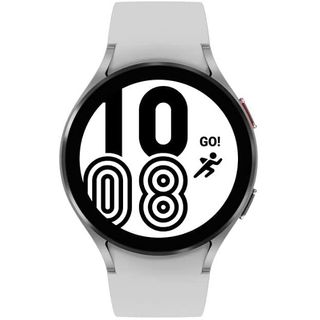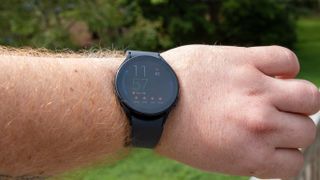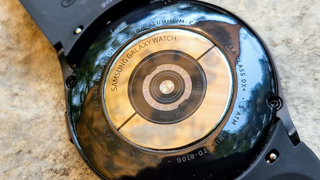Samsung Galaxy Watch 5 vs. Galaxy Watch 4: Should you upgrade?
There's more than meets the eye.

New, shiny, and powerful
The Galaxy Watch 5 may look identical to its predecessor, but there are a lot of new features and changes that aim to improve the experience. From longer battery life, an all-new skin temperature sensor, and faster charging, combine for an incredible smartwatch.
For
- Longer battery life
- Sapphire glass
- Built-in skin temperature sensor
- Faster charging
- Improved sleep tracking
Against
- Same processor, RAM, and storage as Watch 4
- Bora Purple and Pink Gold limited to 40mm variants
- More expensive

Still great, if you can get one
With the Galaxy Watch 4, you won't have to worry about making too many sacrifices. It's still a great smartwatch, but it's not expected to stick around for too much longer.
For
- $30 less expensive
- Same processor, RAM, and storage
- Real-time ECG monitoring
Against
- Uses older Bluetooth 5.0
- Smaller battery life
- Will soon be phased out
It's that time of the year. Not only has Samsung announced its late-2022 flagship phones with the Galaxy Z Fold 4 and Z Flip 4, but we're also getting all-new smartwatches to go along with them.
Last year's Galaxy Watch 4 and Watch 4 Classic provided a radical shift in Samsung's wearable strategy, as the company ditched Tizen after working with Google on the new Wear OS 3. This gave users access to more (and arguably better) apps via the Play Store, while also introducing the company's all-new Bioelectrical Impedance Analysis (BIA) sensor.
With the Galaxy Watch 5 being made official, it's time to dive in and see how Samsung's new watch stacks up against last year's best Android smartwatch.
Samsung Galaxy Watch 5 vs. Galaxy Watch 4: What's the same
Why you can trust Android Central

As soon as you take one look at the Galaxy Watch 5, it's obvious that Samsung decided to take the "if it ain't broke, don't fix it" approach. When compared to the Galaxy Watch 4, you might even have a difficult time telling the two apart.
The Galaxy Watch 5 is available in the same two different case size options; 40mm and 44mm, while keeping the display size the same with a 1.19-inch for the former, and a 1.36-inch display for the latter. Even the dimensions of both generations of smartwatches are the same, which is great if you were worried about Samsung trying to change things up with the Watch 5.
Under the hood, it's more of the same, as Samsung is continuing to use its Exynos W920 chip paired with 1.5GB of RAM and 16GB of onboard storage. When it comes to navigation, you'll find two buttons on the right side of the case, while Samsung's unique digital bezel returns yet again for the standard Watch 5. This gives you scrolling functionality, essentially acting as a digital crown, without physically having the crown.
| Header Cell - Column 0 | Samsung Galaxy Watch 5 | Samsung Galaxy Watch 4 |
|---|---|---|
| Display | 1.19-inch (396x396, 330ppi), 1.36-inch (450x450, 330ppi) | 1.19-inch (396x396, 330ppi), 1.36-inch (450x450, 330ppi) |
| Processor | Samsung Exynos W920 | Samsung Exynos W920 |
| RAM | 1.5GB | 1.5GB |
| Storage | 16GB | 16GB |
| Battery | 284mAh / 410mAh | 247mAh / 361mAh |
| Wireless charging | Yes | Yes |
| Sensors | Acc (32g), Gyro, Barometer, Ambient Light, Compass, Optical Heart Rate Sensor (8pd), Electrical Heart Sensor (ECG), BIA, Continuous SpO2, Skin Temperature Sensor | Acc (32g), Gyro, Barometer, Ambient Light, Compass, Optical heart rate sensor(8PD), Electrical heart sensor(ECG), Biological Impedance Analysis (BIA) |
| Connectivity | BT 5.2 / Wi-Fi 2.4GHz & 5GHz / GPS / NFC / LTE | BT 5.0 / Wi-Fi 2.4GHz & 5GHz / GPS / NFC / LTE |
| Navigation | 2 button + digital bezel | 2 button + digital bezel |
| Durability | 5ATM, IP68, MIL-STD-810H | 5ATM, IP68, MIL-STD-810H |
| Build material | Aluminum, Sapphire Crystal Glass | Aluminum case, Corning Gorilla Glass with DX+ |
| Band size | 20mm | 20mm |
| Dimensions | 40.4 x 39.3 x 9.8mm / 44.4 x 43.3 x 9.8mm | 40.4 x 39.3 x 9.8mm / 44.4 x 43.3 x 9.8mm |
| Weight | 29g / 32.8 grams | 25.9g / 30.3 grams |
| Colors | Boa Purple, Graphite, Pink Gold (40mm) / Sapphire, Silver, Graphite (44mm) | Green, Black, Silver, Pink Gold |
When it comes to health and fitness tracking, many of the same sensors are found on both the Galaxy Watch 5 vs Galaxy Watch 4. These include things like Samsung's Biological Impedance Analysis (BIA) sensor, which captures more than 2,400 data points, providing the ability to check your body composition right from your wrist.
Then, we have other sensors like the built-in ECG, and optical heart rate, to go along with sensors that are found in pretty much all of the best fitness smartwatches for activity and step tracking.
Samsung Galaxy Watch 5 vs. Galaxy Watch 4: What's changed

On the surface, you would be hard-pressed to notice any physical differences between the Galaxy Watch 5 vs. Galaxy Watch 4. The most obvious differentiator would definitely be color selection, as Samsung is ditching the Green and Black color options with the Watch 5.
Instead, those who pick up the 40mm version are able to pick between Boa Purple, Graphite, and Pink Gold. If you're snagging the larger 44mm model, you have Sapphire, Silver, and Graphite to pick from.
While the Watch 5 may be visually and physically identical to the Watch 4, Samsung did bring a major upgrade to the display glass being used. Last year's iteration used Corning Gorilla Glass with DX+, which aimed to get as close to Sapphire as possible.
With the Watch 5, Samsung is going for it all and bringing Sapphire glass to its latest smartwatch. According to Samsung, this upgrade makes the Watch 5s glass about 1.6x stronger than its predecessor.

The next big difference between these two smartwatches comes via battery life. Somehow, Samsung managed to pack a larger battery into the Watch 5, using a 284mAh cell on the 40mm model, and a 410mAh battery on the 44mm version.
For the sake of this comparison, the 40mm Watch 4 uses a 247mAh battery, while the 44mm model sees a larger 361mAh cell. According to Samsung, this results in about 50 hours of battery life on a single charge, which is 10 hours more than what the Galaxy Watch 4 has to offer.
Quick charging capabilities have also been improved, as the Watch 5 is capable of reaching 45% battery life in just 30 minutes. And to go along with the new Advanced Sleep Tracking functionality, Samsung touts the Galaxy Watch 5 as being able to provide eight hours of sleep tracking with just an eight-minute charge.
Arguably the biggest new feature coming to the Galaxy Watch 5 lineup is the all-new body temperature sensor. This feature has long been rumored to be arriving, and now it's finally here. While this isn't a new feature for the smartwatch market, it is the first time we've seen a Samsung smartwatch include it. But as opposed to other options, Samsung is using an infrared temperature sensor that aims to provide more accurate results.
Samsung Galaxy Watch 5 vs. Galaxy Watch 4: Should you upgrade?

For the most part, it doesn't really seem that Samsung is doing all that much to tempt Galaxy Watch 4 owners to upgrade to the new Galaxy Watch 5. But that really couldn't be further from the truth. Not only does the Watch 5 provide an additional 10 hours of battery life, but being able to get eight hours of sleep tracking when charging for less than 10-minutes is incredible.
It also includes Bluetooth 5.2 for a more reliable and stable connection with your phone, unlike the Bluetooth 5.0 found in the Watch 4. Plus, thanks to the Sapphire Crystal Glass, you'll enjoy having a much more durable smartwatch.
But if you care about health tracking even in the slightest, the Watch 5 knocks it out of the park. Samsung is continuing to use its excellent BIA sensor but has redesigned the underside of the Watch to provide more reliable readings. And the added skin temperature sensor is just icing on the cake.
Unless you just recently picked up the Galaxy Watch 4, we highly recommend going with the Galaxy Watch 5. Even with using the same processor, there are still enough new changes and features to warrant upgrading from last year's model. And honestly, that's not always the case.
Want to know more? check out our latest Galaxy Watch 5 review.

Same power, better health features
If you're looking to upgrade, Samsung has packed quite a bit of new features into its latest wearable. It might offer the same processor, RAM, and storage, but it makes up for that with better battery life and improved health tracking functionality.

It might be time
The Galaxy Watch 4 represented a major shift in Samsung's game plan for the wearable market. And while it offers the same power for slightly less, it's expected to disappear from store shelves in the near future.
Be an expert in 5 minutes
Get the latest news from Android Central, your trusted companion in the world of Android

Andrew Myrick is a Senior Editor at Android Central. He enjoys everything to do with technology, including tablets, smartphones, and everything in between. Perhaps his favorite past-time is collecting different headphones, even if they all end up in the same drawer.
